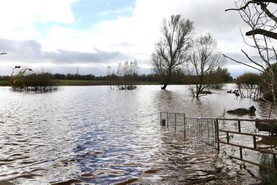New Zealand has provided some helpful pre-Brexit insights into what it takes to be a major exporting force across the world.
I have just returned from a group study trip to New Zealand to examine its red meat sector supply chain and agricultural production systems framework.
The programme, which ran from 12 to 17 March 2018, was organised by the New Zealand Ministry for Primary Industries, Beef & Lamb New Zealand, the New Zealand Meat Industry Association, the New Zealand Ministry for Foreign Affairs and Trade and the British High Commission in New Zealand.
The UK was represented on the study trip by senior industry and government representatives from across all four UK regions.
When you are flying in to New Zealand you can immediately see some similarities with NI with its patchwork of pasturelands, waterways, livestock-based agriculture and rural communities closely connected with the land-based economy.
New Zealand is a country slightly bigger in area than the UK but, with a relatively small population of 4.7m people, its economy is highly dependent on exports of products from its primary industries.
The visit provided an excellent opportunity to get a better understanding of how its government and industry work strategically in partnership to protect the international reputation of New Zealand, to maximise the commercial potential of its primary industries and to create and maintain the widest possible export market opportunities for their country.
Subsidies
People often refer to the agricultural reforms that took place in New Zealand in the mid 1980s when government moved quickly from the old state interventionist and regulated order to a new market-based economy.
The removal of state subsidies was painful and the agriculture industry and rural communities bore a heavy burden during the years of transition that followed.
However, what has happened since is impressive. Since 1990, the agricultural industry in New Zealand has transformed – the dairy herd has increased by 88% in number and by 209% in output, the beef herd has declined by 21% in number but has increased its output by 19% and, while the sheep flock has declined by 53%, its output has only declined by 8.5%.
Scale of enterprise is very different to what we are used to at home with the average cattle and sheep farm typically comprising 2,000 sheep, 200 cattle and 50 deer.
Decision-making by industry at farm and processing level is now heavily driven by data analysis and by end market requirements. Productivity improvements are constantly to the forefront of business planning.
Focus
Whether you are farming in New Zealand, are one of its meat processors or you are part of government, there is a single collective focus on how to deliver a quality and valued product to market in over 100 countries around the world.
Each of these countries has its own market specifications and customer requirements. Considerable resource is invested by both industry and government to secure and maintain market access.
In the past, New Zealand was largely a commodity producer, but it continues to be more focused on how it moves up the supply chain to capture more of the market value.
Having such a broad range of market access is critical to capturing additional revenue and up to 20% of the value of a lamb in New Zealand can now be coming from co-product (fifth quarter) sales.
The New Zealand government and its processing industry work closely together in ensuring that regulation is an enabler to export, that it is outcome focused and that it is not proscriptive.
It’s their mission to avoid costs that don’t add or deliver value, therefore, partnership between the government and industry is both strategic and vital.
A focus on the needs of the customer also drives the New Zealand supply chain. Extending the shelf life of chilled lamb has been a key focus in recent years to service customers in distant markets such as the UK and this is being successfully achieved through a strong focus on hygiene standards and investing in automation to reduce manual handling of carcases in processing plants.
Co-funded
While industry in New Zealand receives no direct subsidies there is a suite of co-funded programmes available from government to enable the industry to improve its position through research and knowledge adoption support.
The aims are to improve its sustainability and profitability, to help with specific national or regional issues such as regeneration of hill country, to control soil erosion and to help recover from adverse events such as earthquakes or biosecurity incursions.
Most of these programmes are well subscribed by industry and a common approach is for communities of farmers to come together and submit proposals for government co-funding of specific projects.
Co-funding is generally 50:50 industry: government but can be higher from the government side depending on the nature of the project/initiative. Like primary industries in most countries of the world, the growing challenge for those in New Zealand is the environment, with water quality very much in the spotlight domestically at the moment.
Although the visit has now completed there is a lot we can learn from New Zealand, particularly about its partnership approach and model of whole chain economic development. The one supply chain approach that has been promoted in NI by the Agri Food Strategy Board appears to be a living and breathing example in New Zealand.






 This is a subscriber-only article
This is a subscriber-only article










SHARING OPTIONS: